Greetings! This presentation is dedicated to the use of technology for fall prevention. It provides administrators and nurses with an overview of bed alarms and their limitations and benefits.
Clinical issue: Patient falls
- A very frequent issue (Mileski et al., 2019), especially:
- with vulnerable populations (e.g., the elderly, reduced mobility, etc.).
- in certain settings (e.g., long-term care).
- when trying to move (from bed) (Balaguera et al., 2017).
- Negative consequences (Morse, Merry, & Bloswick, 2017).
Patient falls are a clinical issue that is likely to affect vulnerable populations. It can also be prevalent in specific settings. Most of the incidents occur when one attempts to move (Balaguera et al., 2017). Furthermore, falls are dangerous; up to 50% of them result in injuries, and lethal cases are also possible (Balaguera et al., 2017; Morse et al., 2017).
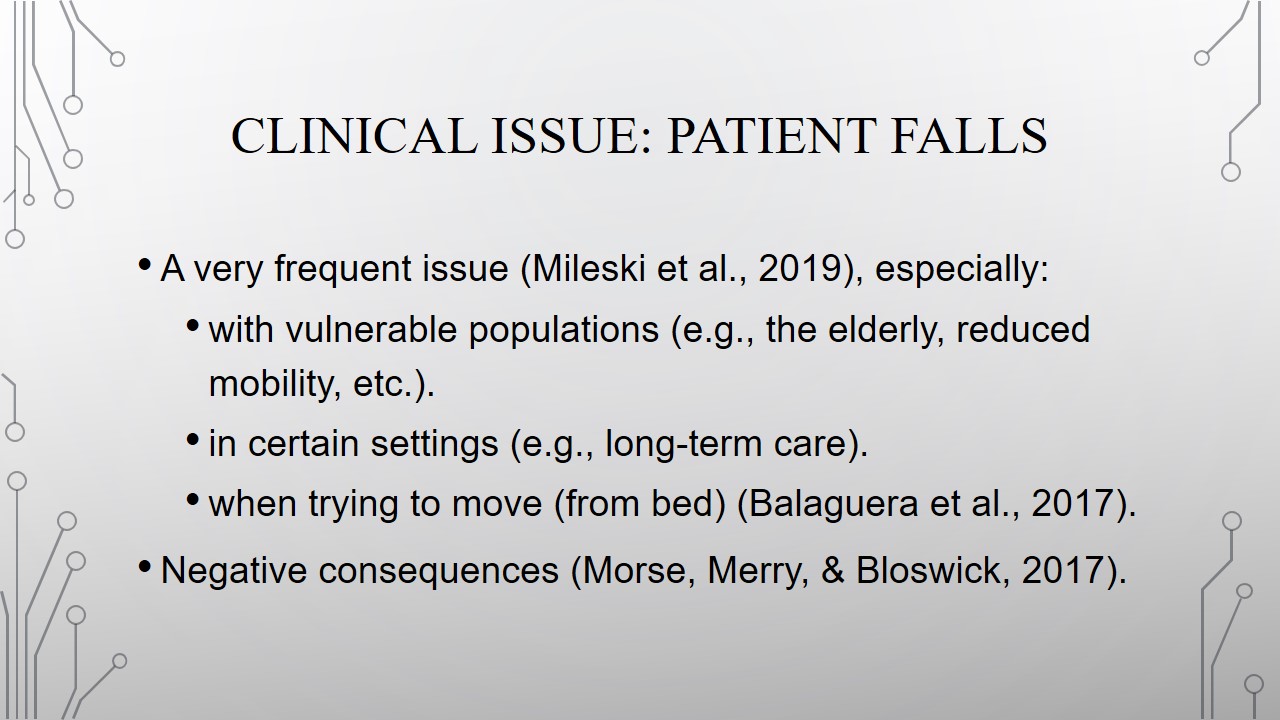
Solution Technology: Bed Alarms
- Long-standing solution (Morse et al., 2017):
- 1982 – air-pressure device under mattresses.
- Newer versions: inbuilt bed alarms, pressure-sensitive devices on beds, wearable alarms, infrared beam-based ones.
- Very recent: intranet alarms (Balaguera et al., 2017).
One of the established solutions is bed alarms. They have been employed since the 1980s when they used air-pressure devices (Morse et al., 2017). These days, multiple options are available. For instance, a study by Balaguera et al. (2017) tested a recently developed alarm system. It consisted of a sensor-based device for a bed, a monitor for patients next to the bed, a mobile monitor for the staff, and an application for the staff’s computers. This system exemplifies the functions of a bed alarm: it is supposed to remind patients that they should wait for help instead of moving on their own and alerts nurses about patients needing assistance.
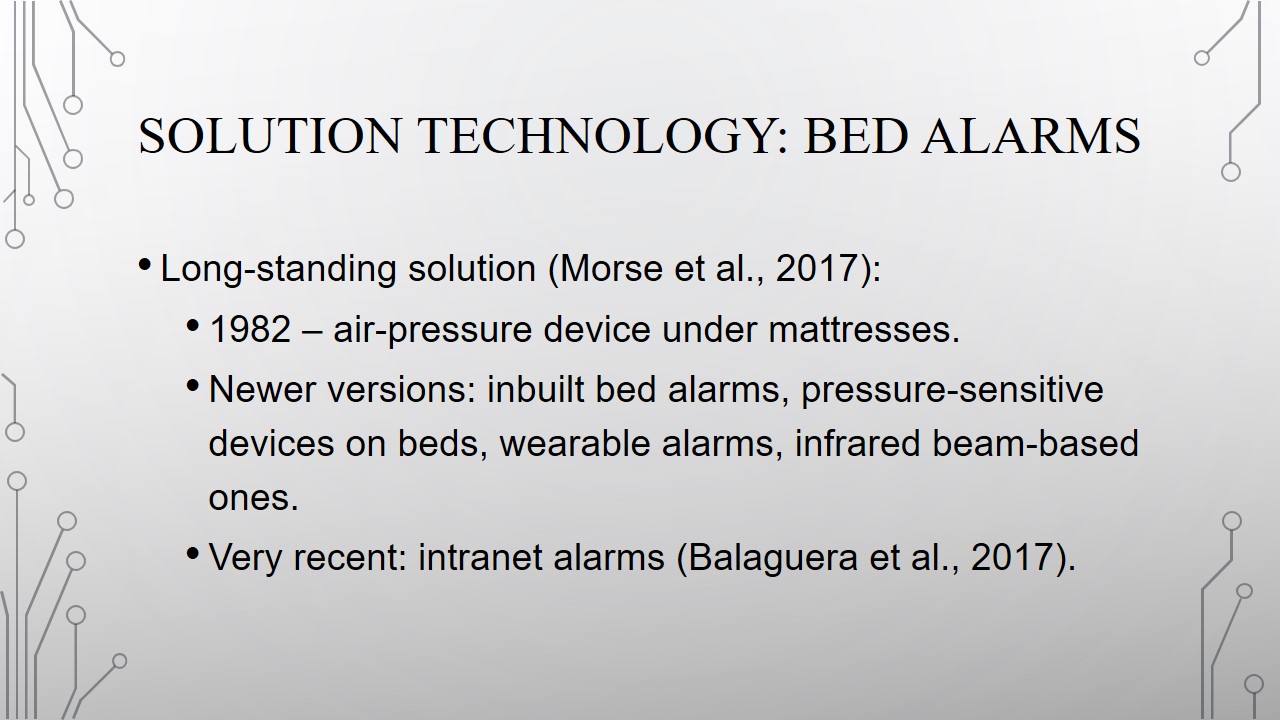
Theory
- Dorothea Orem’s Self-Care Deficit Nursing Theory:
- The idea of self-care need/deficit (fulfilled/compensated by caregivers).
- Can be applied to falls (Dolan & Taylor-Piliae, 2019).
- Good for explaining bed alarms: an intervention for populations that require monitoring.
A theory that can guide this presentation is that by Dorothea Orem. It focuses on self-care, and for fall prevention, the deficit of self-care is important (Dolan & Taylor-Piliae, 2019). Self-care deficit is developed when a patient has a condition that prevents them from ensuring their own functioning; this deficit should be compensated by the medical staff. For bed alarms, the understanding of self-care is critical since this intervention is more helpful for people with particular needs and useless or even harmful for others.
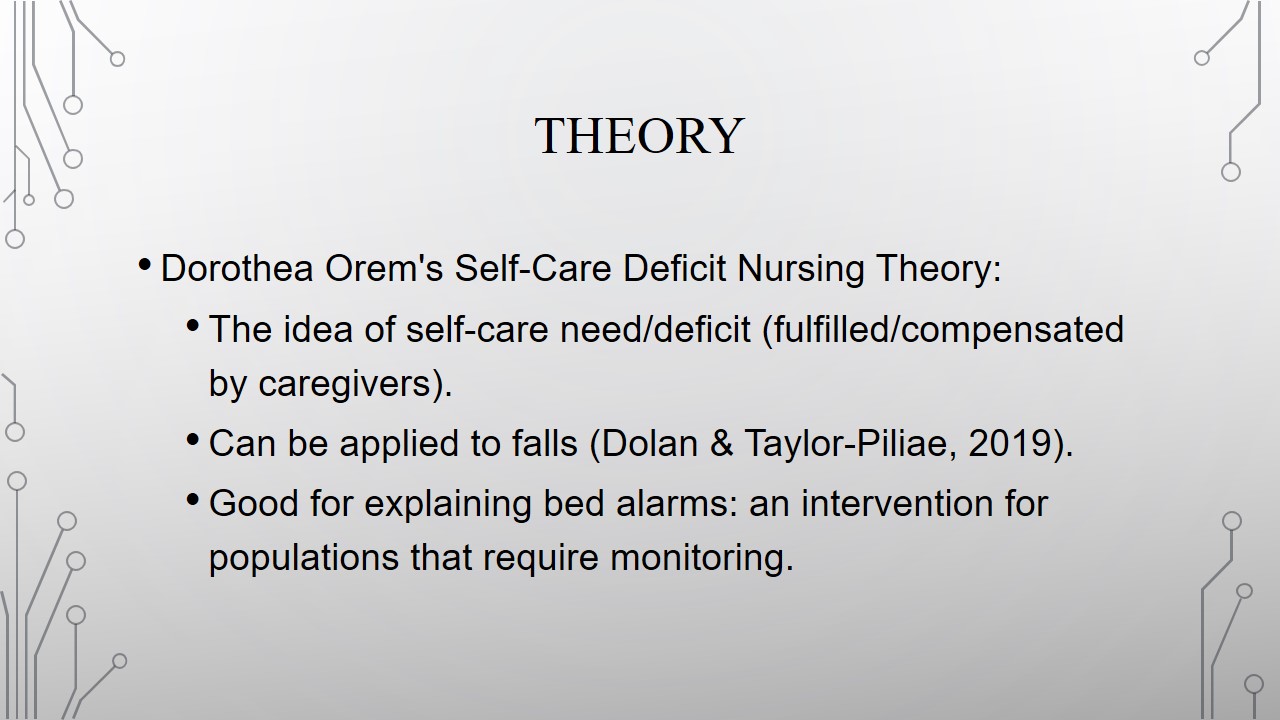
Reducing falls using bed alarms
- Assessing patients: any self-care deficit?
- Risk factors checking (e.g., age, movement restrictions, limited awareness).
- Monitoring patients (with consent).
- Result: vulnerable patients have supervision when needed.
- Combining interventions (Mileski et al., 2019).
Indeed, the first step toward applying bed alarms is assessing patients’ needs. A specialist should determine patients’ self-care deficits to learn if they require bed alarms. Most likely, people who are older, have difficulty moving, or demonstrate limited awareness need alarms (Mileski et al., 2019). It is also important to obtain patients’ consent. Then, alarms can be used for the enhanced monitoring of the patients who require it. However, this technology is not supposed to be used on its own; complex interventions are needed for successful fall rate reductions (Mileski et al., 2019; Morse et al., 2017).
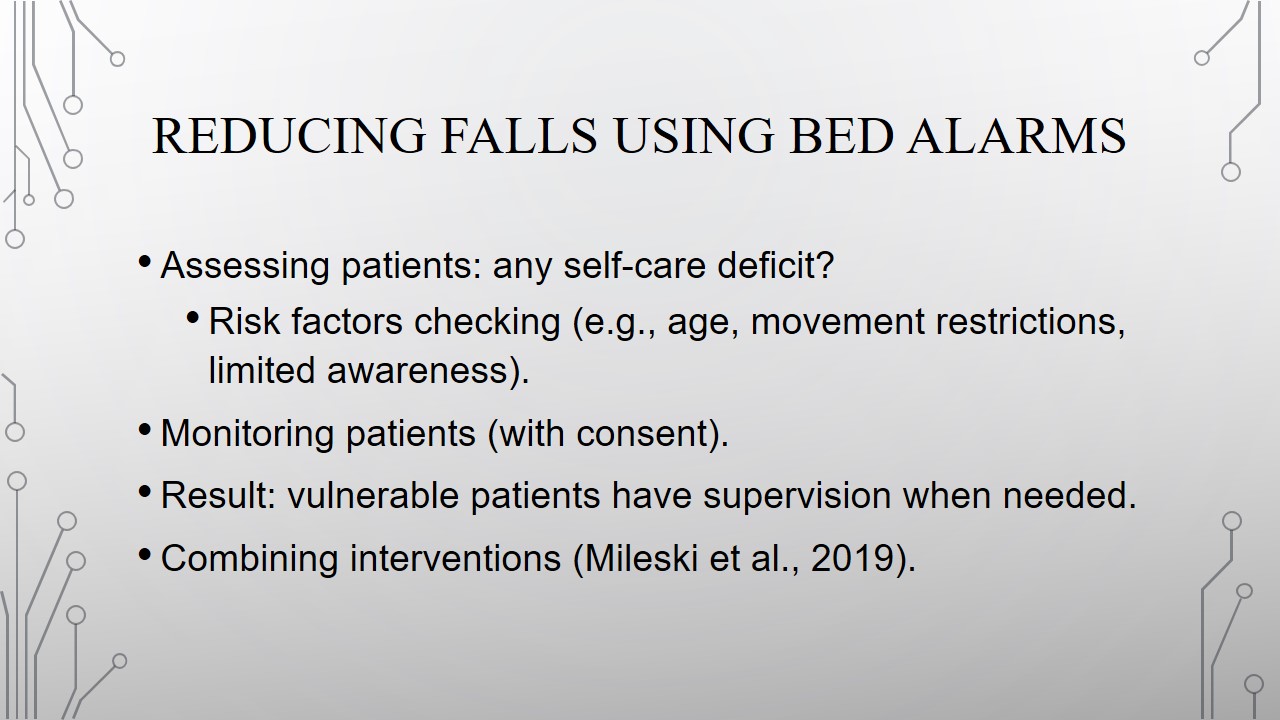
Research: Limitations?
- Contradictory findings (different systems tested):
- Subermaniam et al. (2017): positive effect of alarms.
- Cuttler, Barr-Walker, & Cuttler (2017): an effective complex intervention with bed alarms.
- Gavaller, Gavaller, and Oh (2019): a correlation of removing bed alarms and falls reduction (not certain).
Research on the topic might appear contradictory. Multiple studies suggest the ability of alarms to reduce falls; a recent example is an article by Subermaniam et al. (2017). Also, research dedicated to more complex interventions can be found; Cuttler et al. (2017) demonstrate that they can be effective as well. However, there are also studies with different findings; for instance, Gavaller et al. (2019) considered the effect of removing bed alarms, and it was associated with a reduction in falls. The authors stated that their study should not be used to claim that it was the removal of the alarms that caused this effect. Also, the presented studied considered different devices, which makes their comparison rather difficult. Thus, it cannot be denied that the adoption of bed alarms is not always successful, although it can compensate self-care deficits of some patients.
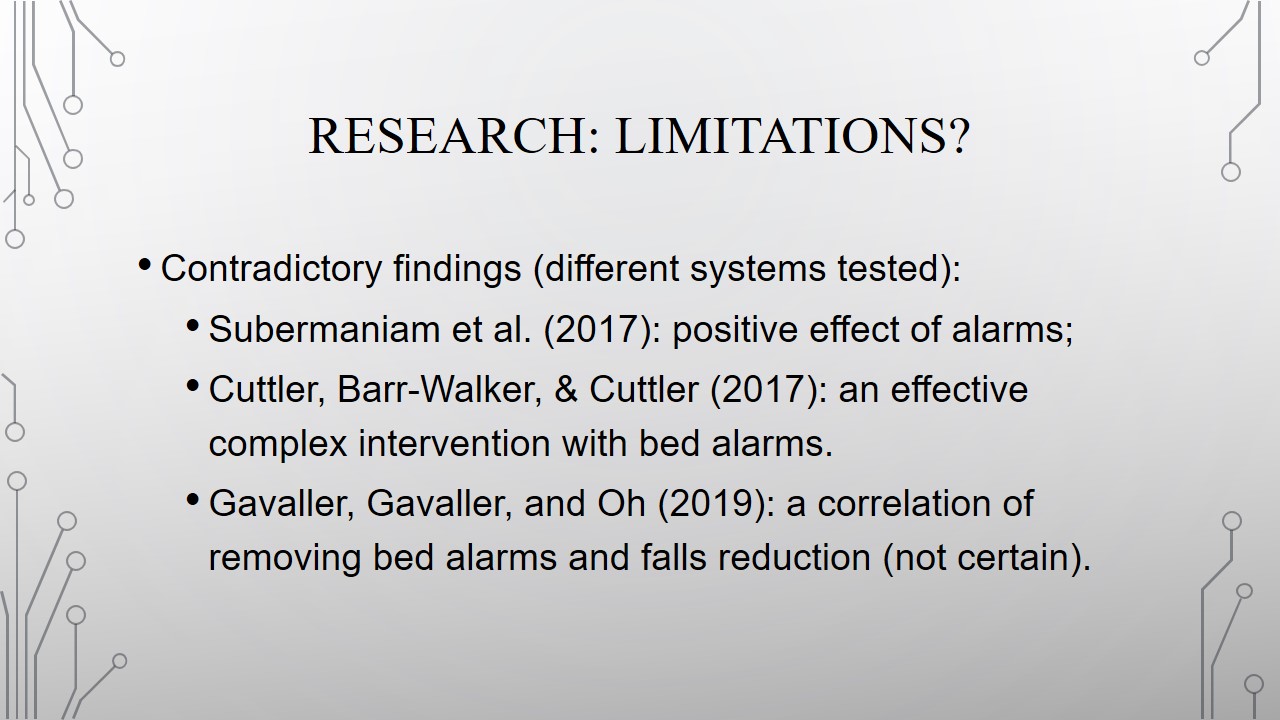
Limitations of the technology
- Drawbacks: costs, restriction, negative reactions/resistance, noise pollution (Schoen, Cull, & Buckhold, 2016).
- Failures: false alarms, lack of alarm.
- Human errors (response time, alarm fatigue, forgetting to switch the alarm, etc.) (Morse et al., 2017).
Bed alarms have drawbacks, including their costs and the fact that they produce noise. The noise might be irritating or cause distress (Schoen et al., 2016), which is why the assessment and consent of patients are crucial for applying this technology. Furthermore, alarms might fail, and human error can also reduce the effectiveness of such devices. For example, nurses report alarm fatigue, and response time is a crucial factor (Morse et al., 2017). Therefore, there are multiple ways in which a healthcare organization might fail to make bed alarms effective.
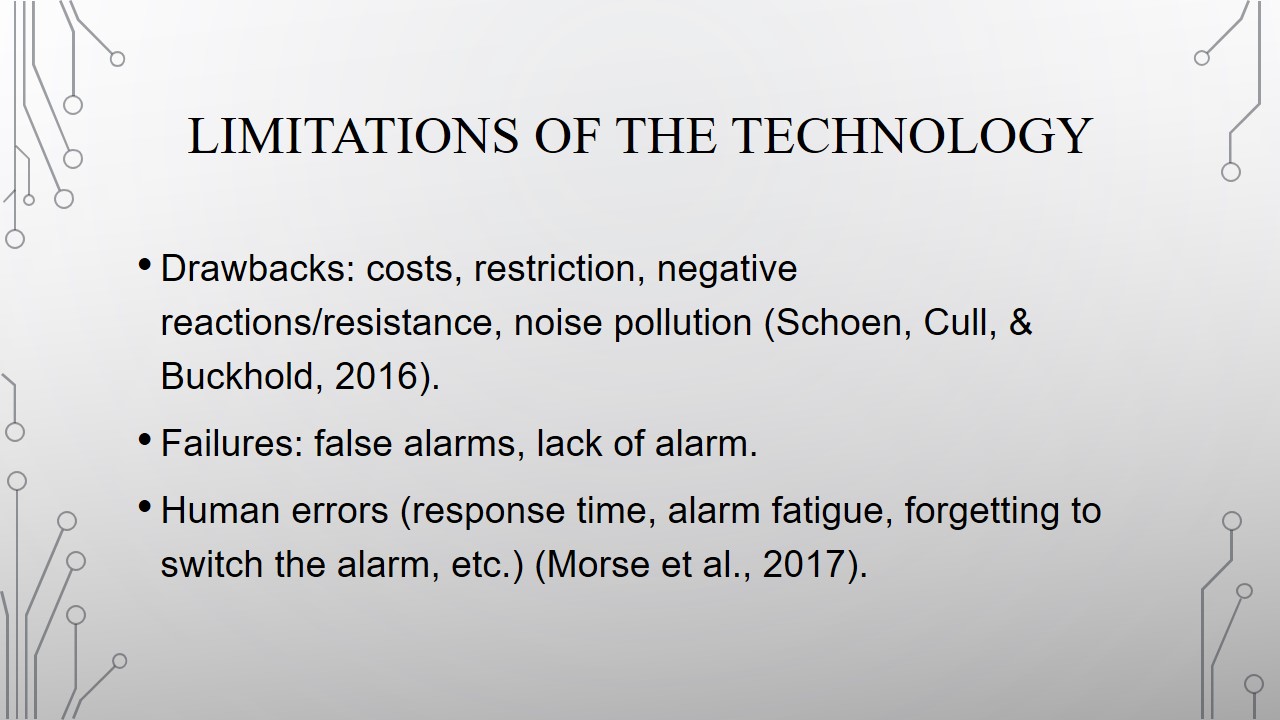
Strengths of the technology
- A viable monitoring method (Morse et al., 2017).
- Meant for certain populations.
- Improves with time (Balaguera et al., 2017).
- Meant to be used with other interventions (combinable) (Cuttler et al., 2017).
Still, bed alarms are a viable monitoring method, which may be very important for certain groups of patients (Morse et al., 2017). Also, this technology is still being developed (Balaguera et al., 2017). Finally, this approach is not meant to be used on its own, and it can be integrated into a more extensive program easily (Cuttler et al., 2017). As a result, when this technology is used appropriately with a population that exhibits relevant self-care deficits, it can be a very helpful tool for administrators to consider and nurses to use.
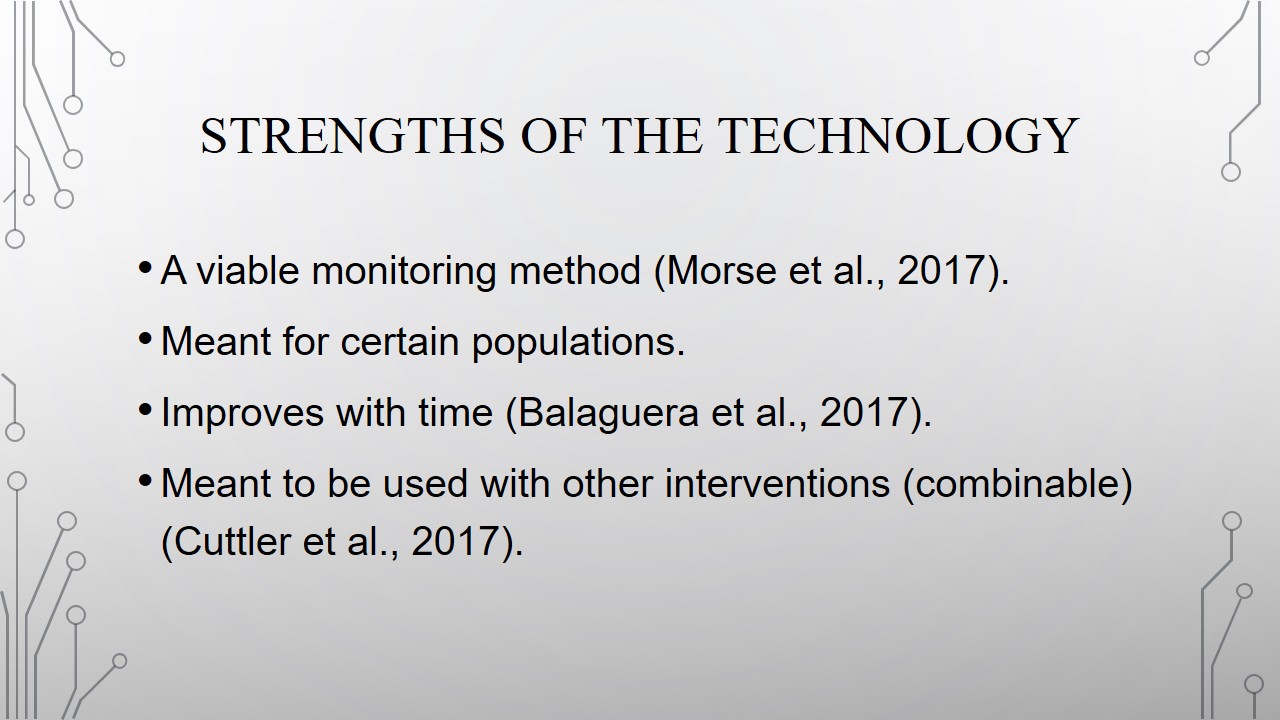
References
Balaguera, H. U., Wise, D., Ng, C. Y., Tso, H. W., Chiang, W. L., Hutchinson, A. M., … Wang, C. J. (2017). Using a medical intranet of things system to prevent bed falls in an acute care hospital: A pilot study. Journal of Medical Internet Research, 19(5), e150. Web.
Cuttler, S., Barr-Walker, J., & Cuttler, L. (2017). Reducing medical-surgical inpatient falls and injuries with videos, icons and alarms. BMJ Open Quality, 6(2), e000119. Web.
Dolan, H., & Taylor-Piliae, R. (2019). Selecting a theoretical framework to guide a research study of older adults’ perceptions and experiences of falling in the hospital. Applied Nursing Research, 47, 38-40. Web.
Gavaller, M., Gavaller, M., & Oh, H. (2019). Impact of bed alarm removal and implementation of hourly rounding to reduce falls. Journal of the American Medical Directors Association, 20(3), B19. Web.
Mileski, M., Brooks, M., Topinka, J. B., Hamilton, G., Land, C., Mitchell, T., … McClay, R. (2019). Alarming and/or alerting device effectiveness in reducing falls in long-term care (LTC) facilities? A systematic review. Healthcare, 7(1), 51-62. Web.
Morse, J., Merry, A., & Bloswick, D. (2017). Research approaches to the prevention and protection of patient falls. In H. Hsiao (Ed.), Fall prevention and protection:Principles, guidelines, and practices (pp. 341-367). Boca Raton, FL: Taylor & Francis Group.
Schoen, M., Cull, S., & Buckhold, F. (2016). False bed alarms. JAMA Internal Medicine, 176(6), 741. Web.
Subermaniam, K., Welfred, R., Subramanian, P., Chinna, K., Ibrahim, F., Mohktar, M., & Tan, M. (2017). The effectiveness of a wireless modular bed absence sensor device for fall prevention among older inpatients. Frontiers in Public Health, 4, 1-6. Web.